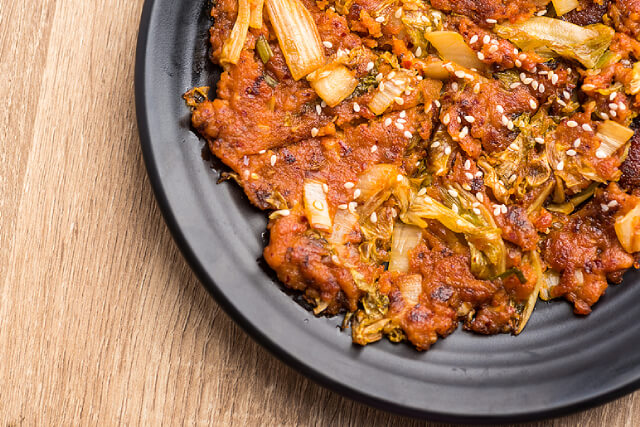Korea is undeniably a food paradise. No matter what you’re craving for, whether it’d be a crispy jeonor a piping hot samgyetang, trust that you can satiate your cravings just about anywhere. And when it comes to appetisers, the Korean cuisine doesn’t disappoint! We’ve gathered 3 must-try appetisers that will keep you busy munching before it’s quite time for dinner.
1. Kimchi Jeon (김치전)
Kimchi Pancake, otherwise known as Kimchi Jeon, evokes a special memory for many Koreans, especially in those that have lived in the countryside. This dish makes its appearance during rainy days, alongside a cup of makgeolli to keep one satiated and warm.
Just as the name suggests, this South Korean pancake incorporates kimchi, preferably ripe kimchi, with a simple flour batter. Its simple recipe allows flexibility and variation, and if you wish to add an egg or two, or be a little fancy and incorporate squid, you can!
These pancakes are typically served with a dipping sauce on the side, but tastes just as delicious without with. You can enjoy kimchi jeon as a quick appetiser, but it can also be served as a main or side dish.
2. Yukhoe (육회)
If you’re aware of beef tartar, let us introduce yukhoe! If directly translated, yukhoe means raw meat. In the strictest context, this means that you can make this dish from any kind of meats. Colloquially, however, yukhoe is typically made out of marinated raw beef slices. The dish is always served with a raw egg yolk on top, whilst Korean pear is served on the sides.
As with sushi, one should always be vigilant when handling raw meat. Since yukhoe uses raw beef, it’s imperative that one uses only fresh meat. It is recommended that defrosting does not go beyond one day, and the meat itself should not be aged for more than a day after slaughtering. If the freshness is compromised, your beef may get contaminated with bacteria and E.coli – which is the last thing you’d ever want.
3. Dongchimi (동치미)
A tad different from the rest, dongchimi is a white radish pickle staple that’s often prepared in late fall or early winter. Traditionally, dongchimi is made with small radishes that are then salted and later placed in a jar of pickling brine for a few weeks. It’s left to ferment and develop an umami-rich kimchi flavour.
Thankfully, you don’t need to wait for a month or two to get a taste of this light and refreshing clear soup. With the help of technology (more specifically, a mixer or a food processor), it can be ready to eat as early as 72 hours after making it!
You may add whatever additions you prefer, be it garlic, Korean pear, green chilli and more. Apart from having it as an appetiser, dongchimi can be served as a side dish as well.
These mouthwatering appetisers are definitely an excellent way to set up your gastronomic adventure. Main dishes deserve their spotlight in their own right, but appetisers set the foundation for a pleasant dining experience.
Whilst you head on to your nearest restaurant to get your Korean food fix, we hope you can try your hand and make them in the comforts of your kitchen. Bring a part of Korean culture and tradition into your home! Get as close to the real source by following Korean recipes from the locals themselves!
If a language barrier is stopping you from trying these at home, it’s time to enrol in a Korean language course! Don’t let a lack of Korean language skills stop you from exploring the wonders that Korean cuisine can offer.


